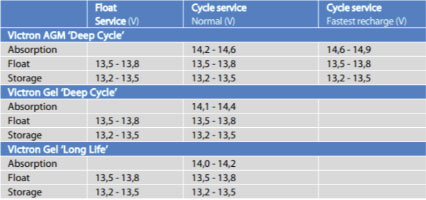The auxiliary battery is usually the most expensive and “fragile” element of a camper electrical installation. For this reason we believe that you should know what each of the charging stages a battery goes through and how to treat them in order to extend its useful life.
Diagram with the stages of charge of a battery
As a picture is worth a thousand words, we have represented in the following diagram how the voltage and current should vary during an optimal charging process, by stages, of a battery.

If this graph has clarified you as much as it did us at the time 😅, do not worry that now we will go into more detail and explain what each of these phases consists of. Also, at the end we’ll add an extra that, at some point, you may find useful.
Bulk or initial charge
In this first phase of charging the charge regulator is not doing anything, since the maximum possible current intensity is provided to the battery, so its voltage increases rapidly until it reaches more or less 12.6V. Once this limit is reached, the voltage will continue to rise more slowly until it reaches between 13.5 and 14.8V, depending on the type of battery and the model. This voltage value is called the absorption voltage and, at this point, the battery should have between 70 and 90% of its charge capacity.
It is at this point that the charge regulator, or any device that allows a staged charging of the battery, becomes important.
Without a device that regulates the charge and performs a staged charge, the bulk phase would be maintained over time and the battery could suffer irreversible damage due to overcharging. This is what happens, for example, when the battery is charged from the alternator by using a battery separator relay.
Absorption
In this second phase the current intensity decreases slowly, while the voltage remains stable at the level reached in the initial charging stage(absorption voltage), between 13.5 and 14.8V, until the battery reaches 100% of its charge capacity.
The function of this phase is to achieve the recovery of the electrolyte, which can be affected after a succession of deep discharges. That is why this phase can last more or less as the battery has suffered deep discharges in a prolonged way or not. It is very important to achieve a complete recovery of the electrolyte.
Flotation
In this third phase the battery is already at 100% of its charge capacity, therefore it is only provided with the necessary current, at a voltage between 12.9 and 14V, to compensate its self-discharge and to keep it at 100%.
If what you need is to store the battery, you must bear in mind that it is not advisable to store a liquid battery, like the AGM, in floating phase during months, on the other hand the gel batteries do support this without problems.
Equalization
The purpose of this “charging phase” is that the gas rises in the electrolyte, so that the mixture becomes a homogeneous solution again and does not accumulate in the lower part, since this could favor the sulfation of the plates. After equalizing a battery, all its cells are brought back to the same voltage.
The equalization is indicated in open lead-acid batteries and totally prohibited in sealed, AGM and gel batteries.
Although this step should not be applied to the batteries that are commonly used as auxiliary in a camper (AGM and gel) it can be very useful to you to have a charger that can do it, since it can come well, in some occasion, to the main battery of your vehicle, in case this one is an open lead-acid battery.
Recommended charging voltages at different charging stages
To know the specific recommended charging voltages for your battery, you will have to look at the manufacturer’s technical data sheet or documentation, since, as we have already said, these voltages may vary depending on the type of battery and its make and model. As an example, here is an image showing a table with the voltages recommended by Victron Energy for its AGM and gel batteries.

It is very important to read the manufacturer’s instructions to know the values of the voltages to be used in each of the charging phases.
Remember that an optimized charging process will improve performance and help not to reduce the life of your battery, so it is very important that you have devices that ensure proper and phased charging.
We know that the electrical installation takes a good part of the budget of the camperization and that every euro counts, but remember that, many times, the cheap, in the long run, comes out expensive? protect the life of your battery and install quality devices!
